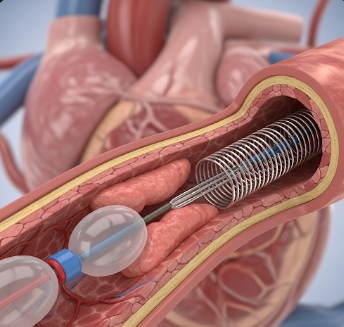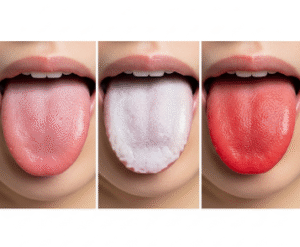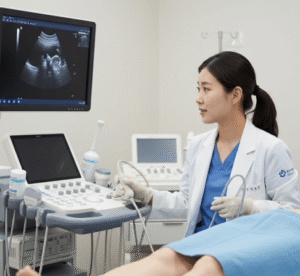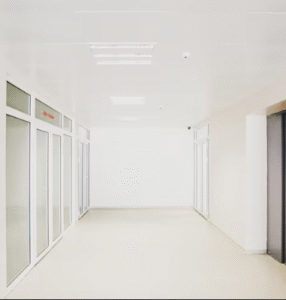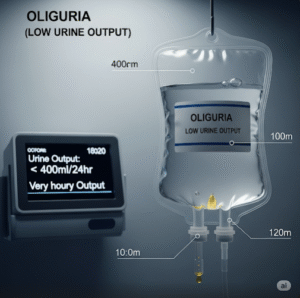Overview
Coronary angioplasty, also called percutaneous coronary intervention (PCI), is a minimally invasive procedure designed to open blocked or narrowed coronary arteries that supply blood to the heart muscle. Often combined with stent insertion, angioplasty restores blood flow, relieves chest pain (angina), and reduces the risk of heart attack.
The procedure involves threading a thin catheter with a balloon into the affected artery. When inflated, the balloon compresses plaque buildup, widening the artery. A stent (a small mesh tube) is usually placed to keep the artery open long-term.
Coronary artery disease (CAD) is the primary indication for angioplasty. CAD occurs when atherosclerotic plaque accumulates inside coronary arteries, reducing blood flow and oxygen delivery to the heart. Angioplasty is widely regarded as a life-saving procedure, offering a faster recovery than traditional open-heart surgery (CABG).
In South Korea, coronary angioplasty with stent insertion is performed in advanced cardiac centers using the latest technology, including drug-eluting stents, bioresorbable stents, and robotic-assisted interventions. Korean hospitals are recognized for high success rates, low complication rates, and comprehensive post-procedure care.
Why It’s Done
Coronary angioplasty is recommended to treat or prevent complications of coronary artery disease.
Primary indications include:
- ➤ Angina (chest pain): Persistent or worsening chest discomfort caused by blocked coronary arteries.
- ➤ Acute myocardial infarction (heart attack): Emergency angioplasty restores blood flow to reduce heart muscle damage.
- ➤ High-risk coronary lesions: Narrowed or multiple-blocked arteries threatening heart function.
- ➤ Failed medical therapy: When medications such as nitrates, beta-blockers, or statins are insufficient.
- ➤ Preventive measure: For patients with significant blockage but no symptoms, to reduce future heart attack risk.
Benefits of coronary angioplasty:
- ✔️ Rapid relief of chest pain and improved quality of life.
- ✔️ Minimally invasive alternative to open-heart surgery.
- ✔️ Short hospital stay and faster recovery.
- ✔️ Reduced risk of heart attack when performed promptly during acute events.
Alternatives
Other treatment options for coronary artery disease may be considered depending on severity, location, and patient factors:
- ➤ Medications:
- Antiplatelets (aspirin, clopidogrel)
- Statins (cholesterol-lowering drugs)
- Beta-blockers, ACE inhibitors, nitrates
- ➤ Coronary artery bypass grafting (CABG): Open-heart surgery creating a new path for blood around blocked arteries.
- ➤ Lifestyle modifications: Smoking cessation, healthy diet, regular exercise, weight management.
- ➤ Enhanced external counterpulsation (EECP): Non-invasive therapy improving blood flow to the heart.
Key difference: Coronary angioplasty is minimally invasive, faster, and often used in urgent situations, whereas CABG is more invasive but may be preferred for multiple or complex blockages.
Preparation
Proper preparation ensures the safety and effectiveness of angioplasty.
Common steps include:
- ✅ Medical evaluation: Blood tests, ECG, echocardiography, and sometimes CT or stress tests.
- ✅ Medication review: Anticoagulants, diabetes medications, or allergy drugs may need adjustment.
- ✅ Fasting: Typically no food or drink for 6–8 hours before the procedure.
- ✅ IV access and monitoring: For medications, sedation, and fluids.
- ✅ Allergy precautions: Especially if sensitive to contrast dye (iodine-based).
- ✅ Consent & education: Doctor explains procedure, benefits, and risks.
How It’s Done
Coronary angioplasty with stent insertion is usually performed in a cardiac catheterization lab (cath lab) under local anesthesia and mild sedation.
Step-by-step process:
- Access site preparation: Local anesthesia is applied to the wrist (radial artery) or groin (femoral artery).
- Catheter insertion: A thin, flexible catheter is threaded through the artery toward the coronary arteries.
- Angiography: Contrast dye is injected to locate the blockage.
- Balloon inflation: A balloon is inflated at the blockage site to compress plaque and widen the artery.
- Stent placement: A stent (usually drug-eluting) is deployed to keep the artery open.
- Balloon removal and closure: The balloon is deflated, the catheter removed, and the access site closed using manual pressure, closure devices, or a radial compression band.
Duration: Typically 30 minutes to 2 hours, depending on complexity.
Hospital stay: Often 1–2 days for elective procedures; urgent angioplasty may require longer monitoring.
Recovery
Recovery after angioplasty is usually rapid compared to open-heart surgery.
Immediate post-procedure:
- ✔️ Patients rest in a monitored bed.
- ✔️ Vital signs and access site checked frequently.
- ✔️ IV fluids administered to flush contrast dye.
At home:
- ➤ Avoid heavy lifting and strenuous activity for at least a week.
- ➤ Resume mild daily activities after 1–2 days if radial access was used.
- ➤ Monitor for bleeding, bruising, swelling, or chest discomfort.
- ➤ Take prescribed antiplatelet medications (dual therapy usually 6–12 months).
- ➤ Follow-up appointments to assess heart function and stent patency.
Long-term care:
- Maintain heart-healthy lifestyle (diet, exercise, smoking cessation).
- Regular cardiac check-ups.
- Manage underlying risk factors: hypertension, diabetes, high cholesterol.
Possible Complications
Although angioplasty is generally safe, complications can occur:
- ⚠️ Bleeding or hematoma at the access site.
- ⚠️ Allergic reaction to contrast dye.
- ⚠️ Blood vessel damage or dissection.
- ⚠️ Restenosis: Re-narrowing of the treated artery (less common with drug-eluting stents).
- ⚠️ Blood clots: May form in the stent, prevented by antiplatelet therapy.
- ⚠️ Rare but serious: heart attack, stroke, or arrhythmia.
Korean hospitals report high safety and low complication rates due to advanced technology, experienced operators, and strict monitoring protocols.
Treatment Options in Korea
South Korea is a leader in cardiovascular care, offering world-class coronary angioplasty and stent insertion.
Why choose Korea for angioplasty:
- 🏥 State-of-the-art cath labs with robotic-assisted and imaging-guided procedures.
- 🏥 Highly skilled interventional cardiologists with extensive experience in complex PCI cases.
- 🏥 Advanced stent options: Drug-eluting, bioresorbable, and latest generation stents.
- 🏥 Comprehensive post-procedure care including cardiac rehab programs.
- 🏥 Medical tourism support: English-speaking staff, coordination, and personalized packages.
- 🏥 Affordability: 40–60% lower than US and Europe, with comparable outcomes.
Hospitals offering coronary angioplasty in Korea:
- Samsung Medical Center, Seoul
- Asan Medical Center, Seoul
- Severance Hospital, Seoul
- CHA Bundang Medical Center
Highlights
- ➤ Coronary angioplasty with stent insertion treats narrowed or blocked coronary arteries.
- ➤ Minimally invasive, with faster recovery than open-heart surgery.
- ➤ Indicated for angina, heart attack, or high-risk coronary lesions.
- ➤ Preparation involves fasting, blood tests, and allergy check.
- ➤ Recovery is rapid, usually 1–2 days hospital stay and gradual return to normal activities.
- ➤ Risks include bleeding, restenosis, blood clots, or rare heart complications.
- ➤ Korea offers advanced, affordable, and internationally recognized coronary angioplasty with high success rates.

